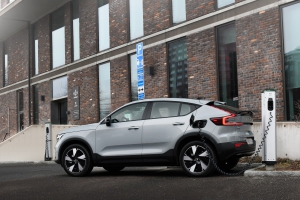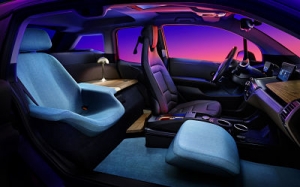2024 Volvo C40: An impressive upscale, compact EV crossover option
Volvo is taking the EV transition very seriously, helping to lead the transition to EVs in the luxury market.
They’re not alone of course — with everyone from Porsche to Audi to Genesis to BMW to Mercedes-Benz also diving head first into electrification. And that doesn’t even include the many EV options from non-luxury brands such as Tesla, Hyundai, Kia, Ford and more.
I recently spent some time in a 2024 Volvo C40, a compact and upscale SUV battling in this growing EV Thunderdome, and I’m back with a full report.
The stylish C40 packs quite a punch into a small package, and will surprise a lot of people with what it can do. (Note: To align with new brand naming schemes, the Volvo C40 will be renamed as the Volvo EC40 for the 2025 model year and beyond)
2023 Volkswagen ID.4 is a classy, user-friendly EV offering
Like most automakers, Volkswagen — one of the largest global OEMS — is fully embracing the arrival of electric vehicles.
While a bunch more EVs are scheduled in the near future (including the long-anticipated ID Buzz van), the one that they have put out as their opening salvo is the Volkswagen ID.4, a compact crossover that debuted in the 2021 model year. It houses five passengers comfortably and features a futuristic design and a respectable range per charge, plus solid tech and safety features.
Competition is stiff, as everyone from Hyundai and Kia to Ford and Chevy are putting out EVs in this size and category. But VW is committed to the EV space in the U.S., even building the ID.4 at its Chattanooga, Tennessee facilities.
I recently drove a 2023 Volkswagen ID.4 AWD Pro S model, and I’m back with a full report on how it measures up in the growing world of EV options.
2022 Volvo C40 Recharge offers peppy all-electric drive, looks and feels like the future
Electric cars are no longer the vehicles of the future. They are the vehicles of today, with seemingly every new vehicle announcement focusing on a new EV.
Volvo is one brand leading the charge in the EV landscape, having announced publicly a goal of selling only electric vehicles by the year 2030.
Volvo’s portfolio today includes the all-electric C40 Recharge – a compact crossover model that takes on competitors such as Ford’s Mustang Mach-E, Volkswagen’s ID.4, Audi’s Q4 e-tron, Mercedes-Benz EQA, and Tesla’s Model Y.
The C40 Recharge competes in a segment that focuses on offering extended range and luxury-light styling. Read on for a full breakdown of how it measures up.
BMW, at CES 2020, to reveal its i3 Urban Suite
At the Consumer Electronics Show 2020 — taking place in Las Vegas January 7-10, 2020 — the BMW Group will be presenting its approach to creating the mobility experience of the future.
For seven years, the BMW i3 has played the role of ambassador for electric driving, sustainability and intelligent connectivity in urban areas. These qualities have helped to make it the world’s best-selling electric car in the premium compact segment.
And now the BMW Group has brought the BMW i3 Urban Suite to this year’s CES in Las Vegas to reveal a mobility experience tailored entirely to the passenger’s individual needs.
2019 Hyundai Ioniq is a leader in plug-in hybrid battlefield
As the automotive world becomes electrified more each year, there is a race to get people further and further on electric power only. But it’s not all pure EVs.
The market for plug-in hybrids is still out there, with the potential to get people great fuel mileage with a bit of an electric boost.
One such entry is the 2019 Hyundai Ioniq Plug-In Hybrid, which I recently got a chance to test. Here’s a full report on how it stacks up in the hybrid arms race.
LOOKS
First introduced in 2017, the Ioniq features a standout design compared to other plug-in hybrids, including a shark-fin style antenna on top.
Unlike some other vehicles in this class, you wouldn’t know it’s a plug-in hybrid if nobody told you. It blends in quite well.
There are 16-inch alloy wheels, plus LEDs all around on its headlights, daytime running lights and taillights.
The inside of the Ioniq is roomy for the class and well-designed, but not fancy. This isn’t a luxury model — but it doesn’t look or feel cheap either..
My test vehicle was a high-end Limited trim level and featured leather seating and heated front seats. It also had a leather-wrapped tilt and telescopic steering.
BMW donates 100 electric vehicle charging stations to America’s national parks
Two years after the launch of a campaign to donate 100 electric vehicle charging stations in and near to national parks throughout the United States, BMW Group has announced successful completion of this project, which was completed in partnership with the National Park Foundation, National Park Service, and Department of Energy. So far, 90 of the charging stations have been installed, with the remaining stations on schedule to open this month.
“We can’t think of a better way to enjoy the summer than visiting one of America’s beautiful national parks. In making electric vehicle charging more widely available for everyone, this joint effort serves to make America’s national parks more accessible to drivers of electric and plug-in hybrid electric vehicles,” said Bernhard Kuhnt, president and CEO, BMW of North America.
The parks leadership said the effort will help boost travel to our national parks by electric vehicle drivers.
“Thanks to public-private partnership, electric vehicle drivers can enjoy a quintessential national park road trip,” said Will Shafroth, president of the National Park Foundation. “Not only will drivers benefit, but also the businesses and communities at the doorstep of our treasured national parks.”
News Categories
Popular Tags
Search Reviews by Make

AutoTechReviews is your home for In-depth reviews of the latest cars, trucks, and SUVs; information on all the emerging vehicle technology; and breaking news from the world of NASCAR and other motorsports.






